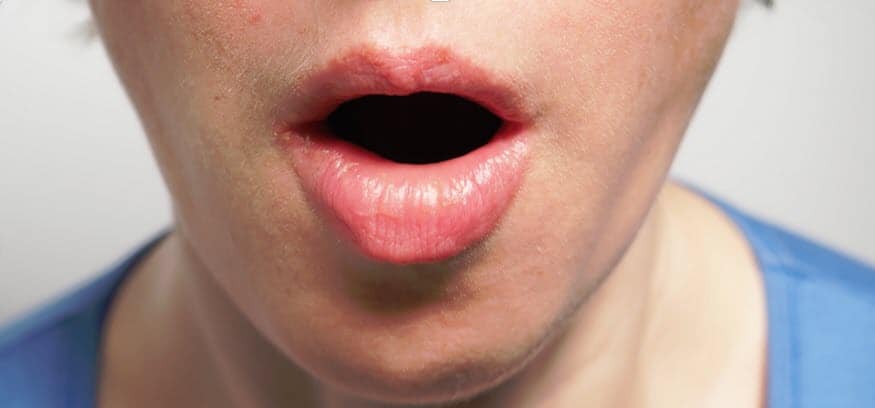A crooked jaw can be caused by any number of things that may require treatment (you can read more about TMJ at Lindenbrook Dental Care in Flint). However, unless the misalignment is notable enough to induce pain, most people wouldn’t consider it an issue. Still, when the bones, tendons, and muscles that make up the jaw are seriously out of sync with each other, the symptoms can range from mild to severe.
Having an uneven jaw bone can cause pain around the jaw joint and temple, even stretching toward the shoulder. Additionally, patients experience tightness in the jaw and cheeks, as well as clicking sounds coming from the joint. Most of the time, that sound is audible to other people as well. However, some people just register it as popping noises in their ears.
Experiencing headaches and pain across the face, particularly around the temporomandibular joint, may reduce the patient’s desire to eat. After all, if chewing becomes painful, they might start opting for more liquid dietary options. But you don’t have to give up food! Still, before we tell you how to fix a crooked jaw, let’s talk about why this misalignment develops in the first place.
Why Is Your Jaw Asymmetrical? Causes and Professional Treatments
When our jaw is functioning properly, it will rotate within the TMJ, cushioned by the cartilage disc. As the masseter muscle that connects our cheekbone to the jaw bone works to open and close the mouth, the jaw should rotate, separating and connecting all teeth at once.
If the back teeth come into contact before the side and front ones, the jaw would have to slide out of the socket to prevent the teeth from grinding. Unfortunately, that’s exactly what happens to patients who have an uneven jaw. While they’re asleep, their masseter muscles often keep the jaw clenched shut, which results in teeth grinding.
If that’s already happened to you, you might want to consider getting a professionally fitted mouthguard. The Lindenbrook Dental Care blog has more information on that particular subject. So if you’re interested in learning about it, visit the blog by clicking here. Basically, the mouthguard will make the lower teeth come in contact with the upper ones at the same time, pushing the jaw back into its joint.
A mouthguard might be a good solution for patients who are suffering from various joint disorders and birth defects too. However, in more extreme cases, reconstructive surgery might be another viable TMJ treatment option. Still, before a dentist suggests something like that, they’ll probably see if braces or retainers can correct the condition.
In any case, this kind of scenario isn’t the only thing that could create an uneven jaw bone. The jaw could also become misshapen as a result of trauma, such as a fall or an assault. Applying a strong force to the jaw could fracture or break it, or even push it out of the joint.
Surgical Options for Correcting Different Causes of TMJ Misalignment
As we have mentioned, surgical intervention isn’t the first solution a dentist might suggest. For example, if one side of your jaw slipped out of its joint during a scuffle, your dentist should be able to physically pop it back in. However, if the underlying cause of your facial asymmetry is teeth misalignment, you might require surgery to correct your jaw alignment.
There are different kinds of procedures your oral surgeon might suggest, depending on the type of misalignment you’re dealing with. For example, they can perform:
- Mandibular surgery to move the front part of the lower jaw forward or back, correcting under and overbites
- Maxillary osteotomy, otherwise known as open bite surgery, which aims to close the gap between the upper and lower front teeth
- Jaw wiring to encourage the jaw to remain in a certain place or support a healing fracture
- Genioplasty to fix a crooked chin, if that’s the only thing that’s giving the appearance of a crooked jaw
Most of these procedures have the goal of making sure that the teeth are all coming into contact at the same time when you close your jaw. That eliminates the need for the jaw to slip out of the joint to close properly.

How to Fix a Crooked Jaw at Home
People with asymmetrical jaws can use several exercises to bring their uneven jaw bone back in formation. First, there’s the masseter stretch. To do the exercise, patients should press their thumbs right below the cheekbone and drop their jaw. Each jaw drop should last for about five seconds, and there should be about five repetitions of the exercise.
Then, there’s the temporalis stretch, wherein we put the heels of our hands to each temple, lightly pushing upwards as we drop our jaw. Once again, we want to keep the jaw down for a few seconds and get a few set repetitions in there. If these exercises sound too difficult or too goofy for your taste, you might achieve a similar effect by simply massaging those muscles with circular motions.
Lastly, many professionals recommend the monkey face exercise as an effective TMJ treatment. Once again, the exercise involves dropping the jaw, but it doesn’t require any hand movements. Instead, you’ll want to drop your jaw while pulling your lips inward over your teeth. It may look silly, but it works!
The point of these exercises is to equally stimulate the muscles on both sides of your face. Since this kind of facial asymmetry is usually caused by the muscles on one side of the face getting lazy, these movements should bring back that functionality.
Tips for Soothing the Symptoms of a Crooked Jaw
The exercises we’ve mentioned will almost certainly do wonders for your jaw — but you shouldn’t expect instantaneous results! If you’re already experiencing pain as a result of your uneven jaw bone, we have a few final tips to share.
For one, applying ice to the painful joint seems to help some people. However, if you have a headache in addition to the joint pain, you might not appreciate the cool sensation. On the other hand, over-the-counter painkillers will surely make quick work of your pain.
While you’re at it, you might want to avoid sudden jaw movements and try to keep your face relaxed. Reducing your overall stress levels could help too since we tend to hold a lot of our anxiety and tension in our jaw.
Ultimately, fixing a crooked jaw isn’t only something you have to do for the sake of vanity. Remember, this condition can also seriously affect your quality of life. So if the exercises and medications don’t do the trick, don’t hesitate to make an appointment with your dentist!

